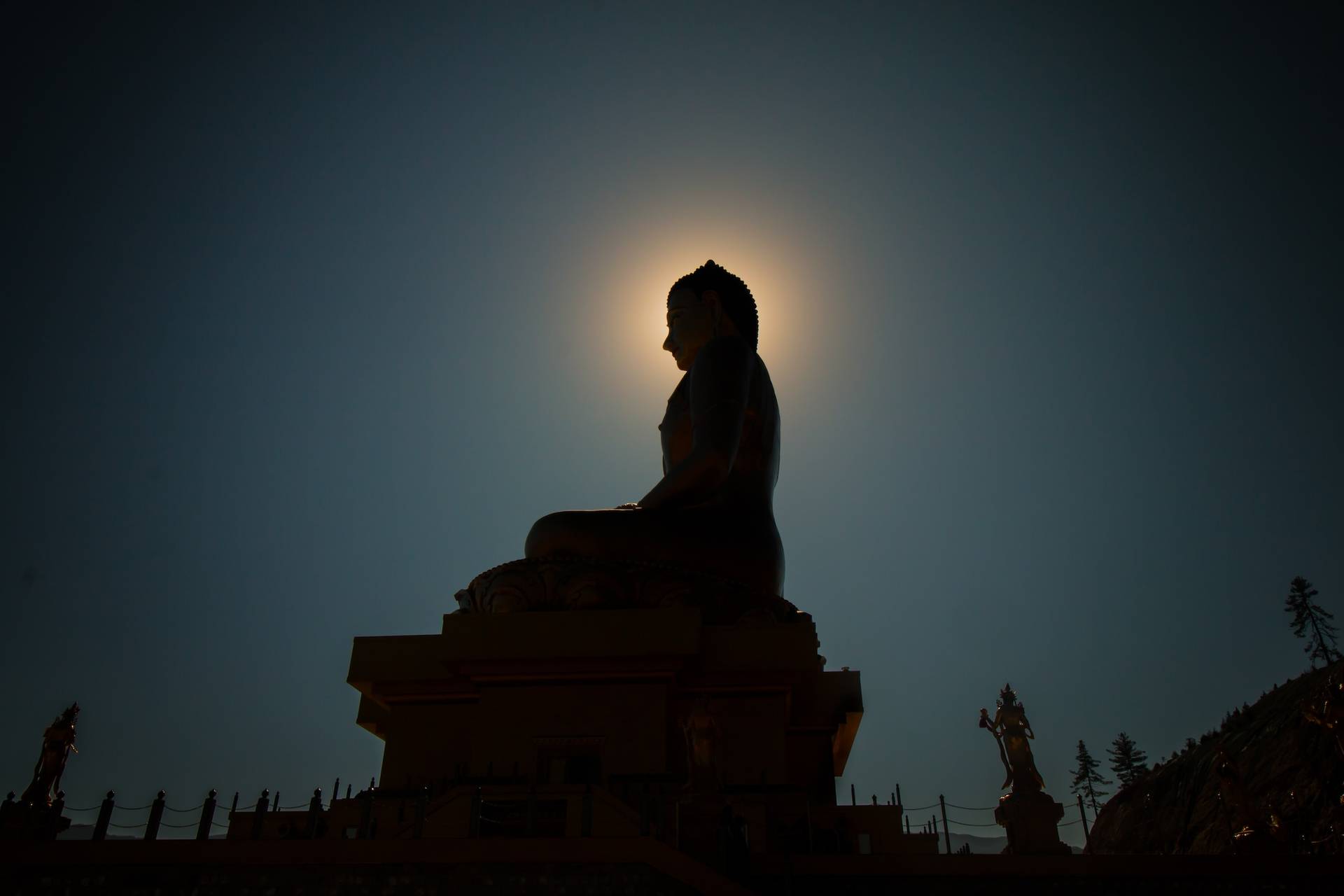
Anātman, the Buddhist Doctrine of No-Self: Why ‘You’ Do Not Really Exist
Often misunderstood as denying personhood, the Buddhist doctrine of no-self (anātman) simply aims to deflate the grasping ego. By seeing ourselves for what we really are — bundles of ever-changing processes — we can undermine anxiety, and live more peaceful lives.

The teachings of the Buddha have one core purpose: to eradicate duḥkha, a Sanskrit word often translated as ‘suffering’, but perhaps stronger than this, intended to capture all of life’s dissatisfaction, disappointment, unfulfilled hopes, and unhappiness.
As we discuss in our explainer of the Buddha’s parable of the poisoned arrow, Buddhists think alleviating duḥkha is our most important task in life — and most of our suffering arises from a fundamental mismatch between how we view reality and reality itself.
The path to ending duḥkha, therefore, lies in facing up to and correcting our false beliefs about the world.
One of our most prominent and damaging misconceptions about reality, the Buddha thinks, is our confused notion of ‘self’. By deflating our conventional notion of ‘self’ and understanding what we really are, the Buddha argues, we can undermine duḥkha, and live more tranquil lives.
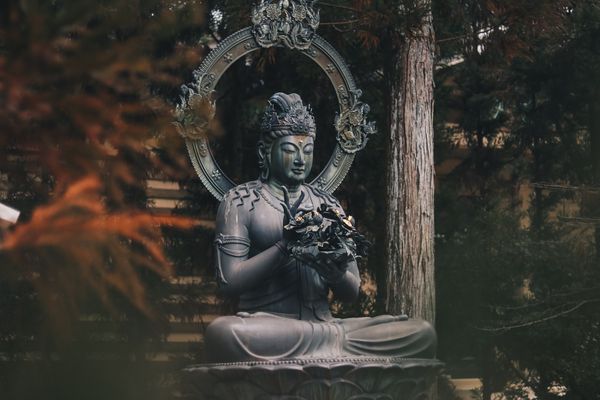
Anātman: ‘you’ do not really exist
On the face of it, the Buddha’s concept of anātman — i.e. no-self: you do not really exist — seems a very strange view, for our sense of self is surely one of the most familiar things to us; but there’s a lot of misunderstanding about what the Buddha really means here. Indeed, there is much discussion within Buddhism itself about what anātman entails: a vast literature sits on top of the Buddha’s original insights, offering many different interpretations and expansions (some more hardline than others).
For the purposes of this article, we’ll contain ourselves to the Buddha’s original teachings as recorded by the suttas in the Pali Canon.
Firstly, it’s important to understand the historical context in which the Buddha was operating, for he was reacting to the Brahminic tradition (a precursor to modern Hinduism) dominant in 500 BCE India. Within this tradition, the concept of ātman — i.e. a permanent self or soul — is crucial.
With his concept of anātman, then, the Buddha is not necessarily denying the convention of people; he is specifically targeting the Brahmin concept of ātman, which involves a persisting essence or substance of self. This may make us think more of the Christian notion of ‘soul’ than our everyday notion of ‘self’, but the Buddha’s view has important repercussions for both.
For, whether we call it soul or self, the Buddha thinks the referents of ‘I’, ‘you’, ‘he’, ‘she’ have no real permanence: they don’t exist in the way we might think they do.
The autobiographical, continuous self — the ‘you’ of last week, yesterday, and today — is just a convention, an invented simplification, a convenient and complacent way to refer to what is in reality a set of immeasurably complex and ever-changing processes.
Think about it: we are changing every second of every day. Our thoughts, desires, moods, memories, the hair on our heads, the nails in our fingers and toes, the cells of our bodies — all is in flux.
So: what makes the ‘you’ of today the same as the ‘you’ of, say, ten years ago? The Buddha’s answer is, well, beyond the causal chain linking you in time, nothing, because the concept of ‘you’ is empty. ‘You’ refers not to some permanent substance; it’s simply a convenient way to refer to the myriad, ever-changing individual processes that, collectively, we call ‘you’.
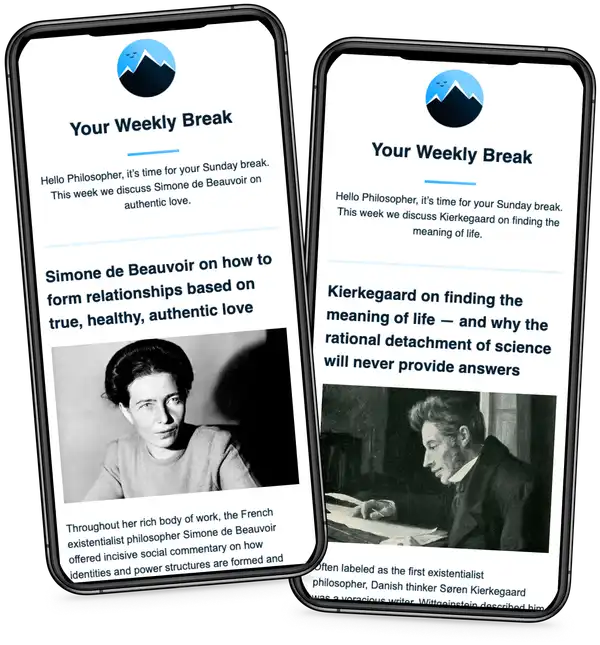
From the Buddha to Nietzsche: join 24,000+ subscribers enjoying my free Sunday Breakdown
In one concise email each Sunday, I break down a famous idea from philosophy. You get the distillation straight to your inbox.
💭 One short philosophical email each Sunday. Unsubscribe any time.
Consider a heap of sand. The word ‘heap’ is simply a convenient way to refer to the fact that there are thousands of individual grains of sand stacked on top of one another. Take the individual grains of sand away, and nothing remains. The ‘heap’ was just a shorthand way of saying ‘thousands of individual grains of sand stacked on top of each other.’
So it is with the self, the Buddha thinks. We use individual names and pronouns like ‘I’, ‘you’, ‘he’, ‘she’, ‘they’, and we may think that in using such words we are referring to individual, persisting entities. But people are not individual, persisting entities — we are composite, ever-changing entities. Like heaps of sand, we are nothing more than the sum of our shifting parts.
A famous Buddhist text that illustrates this thinking is The Questions of King Milinda (not actually included in the original Pali Canon, but considered to be as important as the texts that do), in which the King discusses with the sage Nāgasena the question of what makes a chariot a chariot:
‘Is it the pole that is the chariot?’
‘I did not say that.’
‘Is it the axle that is the chariot?’
‘Certainly not.’
‘Is it the wheels, or the framework, or the ropes, or the yoke, or the spokes of the wheels, or the goad, that are the chariot?’
And to all these he still answered no.
‘Then is it all these parts of it that are the chariot?’
‘No, sir.’
‘But is there anything outside them that is the chariot?’
And still he answered no.
‘Then thus, ask as I may, I can discover no chariot. Chariot is a mere empty sound.’
Nāgasena goes on to explain that just as a chariot is nothing in addition to all its parts, so the self is nothing — no extra thing — in addition to all of our parts.
Like a chariot, the self is simply a convenient fiction, a shorthand reference for the many different parts that make us up. Its existence is based in convention, rather than in some ultimate persisting material of reality.
So, people exist in a conventional sense: we just aren’t what we think we are in an ultimate sense. When we refer to individuals, we are actually referring to great masses of interacting processes, bounded within particular body parts. Your name is simply a shorthand way of grouping thousands of ever-changing processes, which themselves are made up of thousands of smaller processes, and so on.
In fact, much like the subatomic scientific picture of the world, Buddhists think that, at root, everything is simply made of individual pieces of ‘dharma’ — like atoms, but with a minuscule time element, too. Tiny slices of the cosmos in real-time, configured in different ways.
There is a vast Buddhist literature that categorizes these ‘slivers of happenings’ — dharmas — to describe exactly how they make up us and everything we interact with.
The crucial Buddhist insight is that the sum of these tiny slices of the cosmos is not greater than its parts: ‘you’ are nothing more than a composite of the changing thoughts, desires, processes, and atoms that temporarily make you up.
You do not ‘experience’ your perceptions and feelings; you are your perceptions and feelings
The Buddha says all this not to belittle us, but to point out a trick we play on ourselves — a trick that entrenches a flawed view of reality, and so causes suffering.
For, even if we concede we are always physically changing, we might still quietly cling to a ‘mental’ version of the continuous, persisting self.
We might think of this mental self as some kind of pilot of our actions, or the keeper of our internal monologue — and this internal monologue can be very convincing in making us think it’s some kind of persisting entity (consider, for instance, Descartes’s ‘I think, therefore I am’).
But the Buddha’s insight is that this ‘persisting’ mental self emerges only when we are thinking — it is a verb, not a noun. Just as dancing doesn’t exist when one isn’t dancing, so the self only exists when one is thinking or feeling.
This point was famously articulated in the Western tradition of philosophy, too, by the great 18th-century thinker David Hume. Reflecting on his own own stream of consciousness, Hume writes:
For my part, when I enter most intimately into what I call myself, I always stumble on some particular perception or other, of heat or cold, light or shade, love or hatred, pain or pleasure. I never can catch myself at any time without a perception, and never can observe anything but the perception.
In other words, all we find when dwelling on ourselves is a bundle of thoughts and perceptions: we can never use ‘I’ unless it’s attached to a corresponding am / want / think / feel.
The upshot is that, while thoughts and feelings exist, there is no separate ‘I’ — no separate self — experiencing those thoughts and feelings. The person simply is those ever-changing thoughts and feelings. You are sadness one minute; happiness the next.
Hume goes on to conclude that people are thus…
nothing but a bundle or collection of different perceptions, which succeed each other with an inconceivable rapidity, and are in a perpetual flux and movement.
Though it’s supposed Hume came to his views entirely independently, recent research by philosophy professor Alison Gopnik suggests Hume may have been influenced by Buddhist philosophy. Indeed, the Buddha came to these very same conclusions some 2,000 years earlier: the self is an illusion, entrenched by the structure of our language.
The key point is this: though we attempt to impose continuous narrative and meaning on our ‘selves’, these narratives are hopelessly simplified fictions and conventions: in reality, we are incredibly complex, swirling bundles of change.
What makes us continuous with the people we were ten years ago, then, is not some fixed ‘self’, but a particular chain of causes and effects. We mistake our imperfect, ever-shifting memories of this chain for substance, and the convention of ‘self’ emerges.
Why is the self harmful?
In response to this analysis, we might think, well — what’s the harm? Even if the self is nothing more than the sum of its swirling parts, an incredibly complicated web of cause and effect, isn’t it just easier to say ‘I am tired’ rather than something like ‘the current emergent feeling from thousands of ever-changing processes is tiredness’?
Some Buddhists might, to an extent, agree: referring to a self can occasionally be convenient.
But there is a great deal of literature discussing this point, and it should be noted that there are some Buddhist schools that would disagree with the idea that referring to a self is ever productive.
If we follow the Buddha’s original teachings as recorded by the suttas in the Pali Canon, however, we might say there is relatively little harm in using the convention of self as shorthand for the thousands of interacting parts that make ‘you’ up — especially if it helps improve those parts in ways that lessen suffering (‘I will eat more healthily’ benefits a significant number of parts, for example).
But — and here all Buddhist schools would agree — we must remember that the utility of this fictional, conventional self is limited, and actually becomes very detrimental very quickly if we take it too far.
In one concise email each Sunday, I break down a famous idea from philosophy. You get the distillation straight to your inbox:
💭 One short philosophical email each Sunday. Unsubscribe any time.
If we start believing the self is actually real — some kind of independent, persisting substance as opposed to a convenient fiction — the danger is that it encourages us to view everything through its lens: we feel so intimately connected to this self that it becomes the most important thing in the universe.
We then judge reality only by how it impacts this fictional self, which leads us to develop certain attachments and aversions: ‘I like this and I don’t like that’, ‘I want more of this and less of that’, ‘I love this and require it to be content’, ‘I hate this and whenever it happens I am filled with dread and anxiety’.
We become enslaved by the fictional self, by the demands of the ever-changing internal monologue. Like a black hole bending spacetime to trap light, the illusion of self warps reality and traps our thoughts, feelings, and experiences in ego.
And, as the world is fundamentally transient and rarely accords with the hopes and desires we place on it — bad things happen, and good things always end — as long as we continue to view reality through the lens of illusory ego, as long as we continue to grasp for things we imagine this ‘self’ wants, as long as we use flawed mental models as crutches and misunderstand what we really are, we set ourselves up for perpetual suffering.
The dangers of identity
Another harm that comes from viewing the self as a real, independent substance is that it encourages us to attribute certain qualities to it. In other words, we start to cling to certain identities. We become attached to certain ways of thinking about ourselves — both positive and negative — and this leads to real suffering.
Consider ‘I am a failure’ — what does this mean? Which parts of you have failed? The hairs on your skin? Your digestive system? Your ability to count?
Or consider ‘I am a pessimist’ — don’t you experience a mix of hopeful thoughts, too? Is your laughter pessimistic? Why box in your boundless composite existence by selecting only the pessimistic thoughts that bubble up, declaring those to be a true reflection of some persistent ‘self’, and ignoring the great variety and flux of existence?
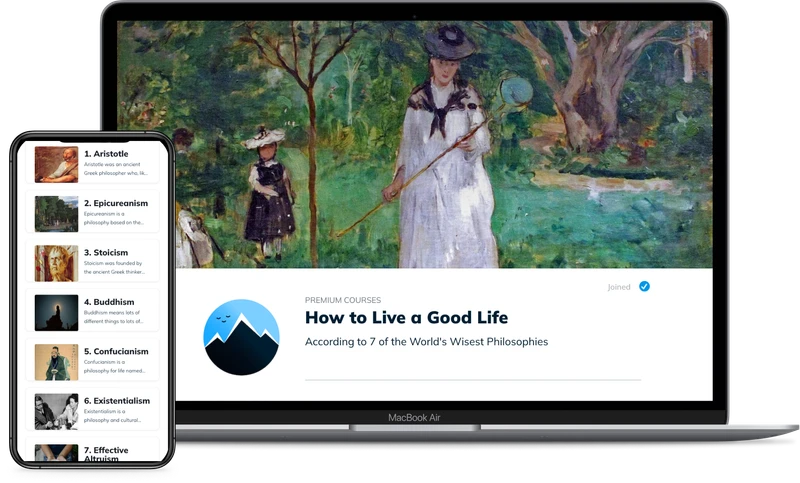
How to Live a Good Life (According to 7 of the World’s Wisest Philosophies)
Explore and compare the wisdom of Stoicism, Existentialism, Buddhism and beyond to forever enrich your personal philosophy.
Get Instant Access★★★★★ (100+ reviews for our courses)
Positive views of self can be just as sinister. Buddhists draw on a powerful image here: imagine a knife smeared with honey. Initially, the knife tastes sweet — but it will soon cause you serious damage.
So it is with a positive sense of identity, the Buddha argues. We might find real pleasure and happiness from it in the short term — ‘I am an athlete! I am a top-tier lawyer!’ — but due to the transience of life we will not sustain such identities forever. One day we’ll wake up to find we no longer quite fit with who we thought we were or craved to be. The honey has all gone; just the knife remains.
Buddhism aims to fix our misconceptions about identity not by showing us the ‘correct’ identity, but by claiming that we do not have an identity at all.
Our recurrent thoughts, feelings, hopes, fears, desires, moods, obsessions, attachments — none of them define us; for nothing does.
When in a transient, composite world we see ourselves for what we really are — ever-changing bundles of the same — we recognize that all identity is fallacy, unbox ourselves from illusions of self, and flow with the swirl.
By releasing ourselves from the distorting gravity of self, we see that we are just like everything else, and not more important than anything else: everything in reality becomes our concern, not just the illusory self’s small, warped part of it.
How can we apply anātman to everyday life?
The Buddhist picture of reality is very far from our everyday view of the world: everything is impermanent (captured by the Pali word, anicca), everything is composite, and the self does not really exist.
When going about our days, we probably don’t have these truths at the forefront of our minds. We might agree with them in quiet moments of reflection, but if we’re eating cereal, or thanking a colleague, we’re probably not thinking ‘life is transient and the self is an illusion.’
Instead, when we are commuting or out with friends, viewing the world through the lens of self, desire, and attachment may come back and play a central role.
So, how practical is the Buddhist teaching of no-self for eradicating suffering, really? How can it help us deal with stress at work? Frustration with politics? Difficult relationships?
The Buddhist scholar Nicolas Bommarito suggests in his book Seeing Clearly (which features in our list of Buddhist philosophy’s best books) that one way Buddhism can play a role here is in helping us recognize everyday life not as fake or unimportant but as a convention: a form of living governed by certain rules and restrictions that we participate in, but the fate of which we aren’t wholly attached to.
So, we can view the world through the lens of self for convenience at work and in society, but we don’t need to get too attached to that lens.
For example, if you were playing a board game with friends and family, the chances are you wouldn’t attach your entire emotional wellbeing to whether or not you win. We could look at our conventional, everyday lives in the same way. We play particular roles in them, but fundamentally we recognize that convention is not reality. The stakes just aren’t that high, for our emotional lives are governed by the truths of reality — impermanence and no-self — not by whether or not we get this promotion or win that award. As Bommarito puts it:
Understanding that it’s just a game doesn’t mean you stop playing altogether; instead the significance of the game changes. Winning is still nice, but when you keep your sense of what the game really is, it doesn’t affect you in the same way. You get a kind of peace of mind, one that’s different from the simple joy of winning, because you relate to the game for what it really is.
In another example, Bommarito asks us to consider being in a museum, but self-conscious about what we look like: “here you are in a building full of wonderful art and you can’t really enjoy it because you’re too wrapped up in your self-image.”
By being too wrapped up by your idea of self, you disengage from the world and miss out on valuable experiences. The solution, Bommarito reminds us, is to recall reality and thereby deflate the self:
Understanding, not just intellectually but viscerally, that you are a composite, relational, and impermanent thing can help to dissolve these barriers and allow you to more fully engage with the world. Sure it makes the applause you get feel less thrilling, but it cuts the roots of a lot of mental habits that are painful and isolating: insecurity, failure, ideas about how ‘your life’ is supposed to go-these all get exposed as deeply mistaken.
Living according to transient identity, status, and attachment will only bring dissatisfaction, the Buddha says; being ever-mindful of the flow will bring peace.
No-self creates room for that central Buddhist value: compassion
Beyond the lessening of personal suffering, perhaps the most important practical outcome that comes from deflating the self is the room it creates for compassion. By moving the grasping, reality-warping self out of the way, we better recognize that, though we may be trapped in duḥkha, so is everybody else we know.
The existence of every sentient being is characterized by suffering, for exactly the same reason ours is: we live transient lives of ignorance and pain.
In encouraging detachment from self, then, Buddhism does not look away from reality. It’s not here to free us from the world; it’s here to free us for the world. Honing selflessness through Buddhist practice, we (as with Iris Murdoch’s process of ‘unselfing’) put grasping ego to one side, open ourselves to reality, and cultivate love and compassion for all living beings.
Learn more about Buddhist philosophy
If you’re interested in learning more about no-self, compassion, and other Buddhist teachings on how we can alleviate anxiety, unhappiness, and suffering — including the Buddha’s Four Noble Truths and Eightfold Path — then consider signing up to our new guide, How to Live a Good Life (According to 7 of the World’s Wisest Philosophies).

How to Live a Good Life (According to 7 of the World’s Wisest Philosophies)
Explore and compare the wisdom of Stoicism, Existentialism, Buddhism and beyond to forever enrich your personal philosophy.
Get Instant Access★★★★★ (100+ reviews for our courses)
About the Author

Get one mind-opening philosophical idea distilled to your inbox every Sunday (free)
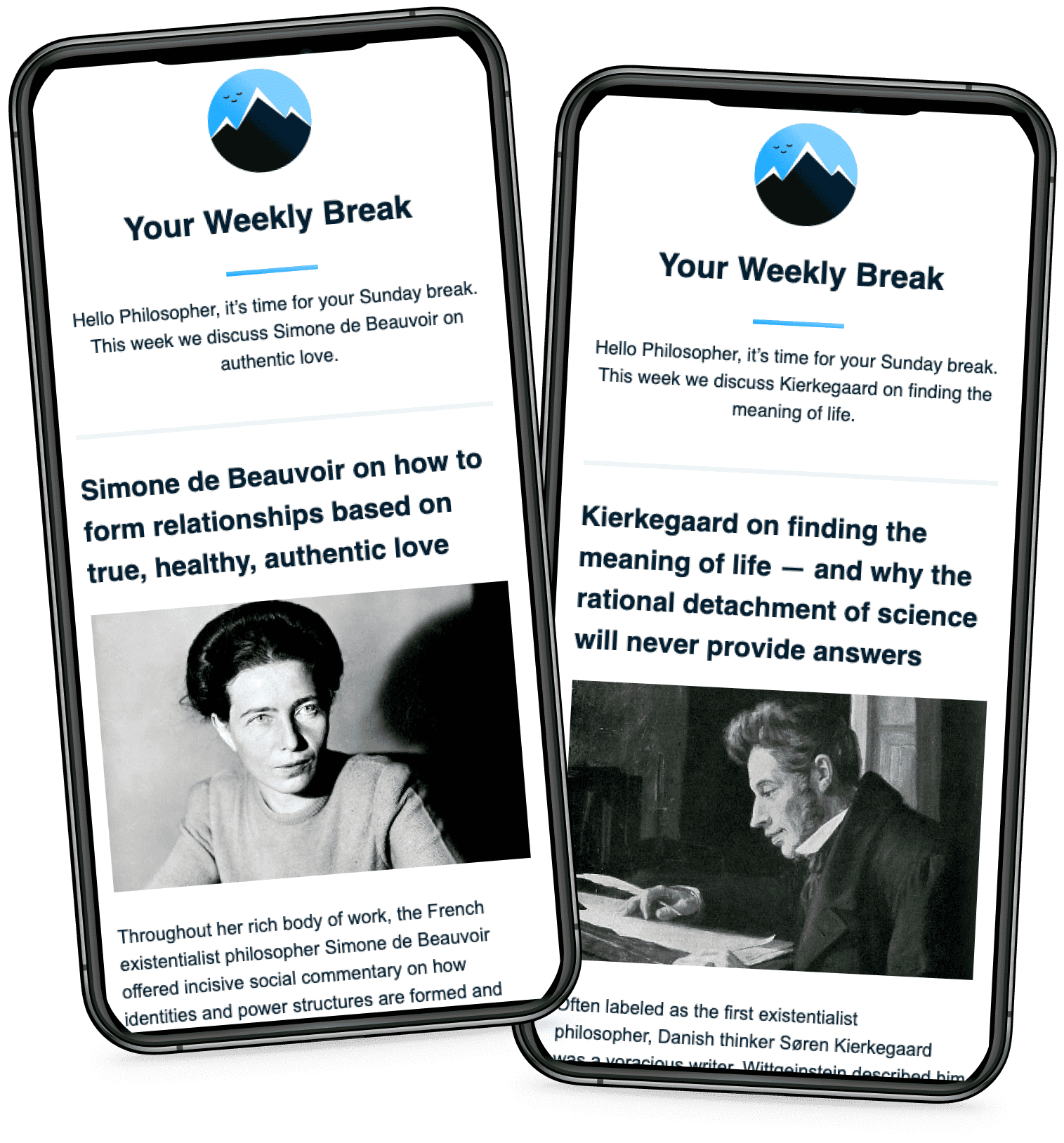
From the Buddha to Nietzsche: join 24,000+ subscribers enjoying a nugget of profundity from the great philosophers every Sunday:
★★★★★ (100+ reviews for Philosophy Break). Unsubscribe any time.

Take Another Break
Each break takes only a few minutes to read, and is crafted to expand your mind and spark your philosophical curiosity.





